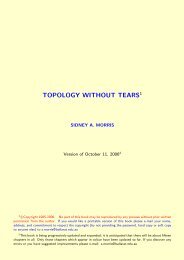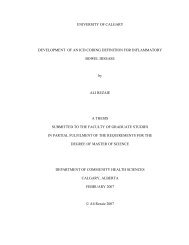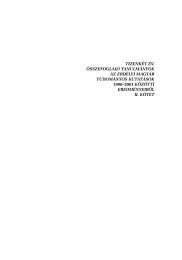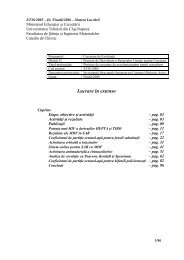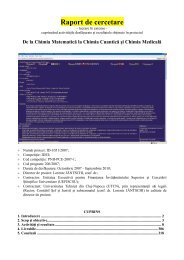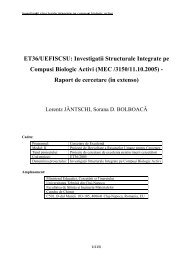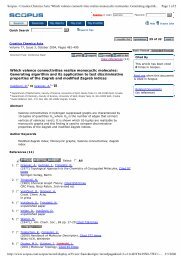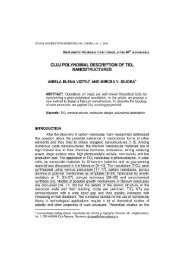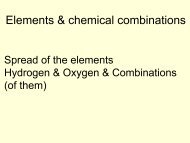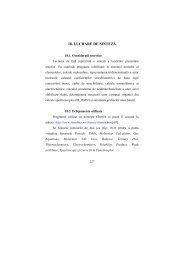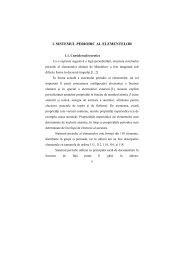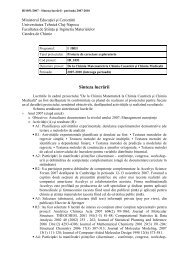periodic - Lorentz JÄNTSCHI
periodic - Lorentz JÄNTSCHI
periodic - Lorentz JÄNTSCHI
Create successful ePaper yourself
Turn your PDF publications into a flip-book with our unique Google optimized e-Paper software.
Elements & chemical combinations<br />
Periodic system<br />
Periodical properties<br />
http://vl.academicdirect.org/general_chemistry/<strong>periodic</strong>_system
Periodic system
•<br />
•<br />
•<br />
At the basis of the classification of the elements stays<br />
the atomic number, Z – representing the total number<br />
of electrons in the atom and in same time the number of<br />
protons in the nucleus<br />
Elements in the <strong>periodic</strong> system are placed on vertical<br />
columns – the groups, and in horizontal rows –the<br />
periods. The succession in the periods is with respect to<br />
the main levels of energy and to the electrons layers.<br />
The period number is equal to the main quantum<br />
number (of the layer being filled). The number of the<br />
group represents the number of the electrons of this<br />
layer being filled, and plays the main role in the<br />
expression of the chemical properties. Thus, it exists a<br />
similarity of the properties inside groups.<br />
Chemical properties are determined by the atom's<br />
tendency to reach as much as possible at stable electron<br />
configurations and to use as many as possible the orbital<br />
valences.
85 At<br />
34 Se<br />
52 Te<br />
84 Po<br />
83<br />
86 Rn<br />
54 Xe<br />
36 Kr<br />
10 Ne<br />
18 Ar<br />
53 I<br />
35 Br<br />
17 Cl<br />
9 F<br />
11 Na<br />
19 K<br />
16 S<br />
8 O<br />
Bi51 Sb33 As15 P 7 N<br />
2 He 3 Li<br />
6 C<br />
14 Si<br />
32 Ge<br />
50 Sn<br />
82 Pb<br />
1 H<br />
5 B<br />
37 Rb<br />
13 Al<br />
31 Ga<br />
49 In<br />
81 Tl<br />
87 Fr<br />
55 Cs<br />
56<br />
Sr<br />
Ca38<br />
12<br />
Mg20 Ba<br />
4 Be<br />
30 Zn<br />
48 Cd<br />
80 Hg<br />
88 Ra<br />
39 Y<br />
21 Sc<br />
29 Cu<br />
57 La<br />
47 Ag<br />
89 Ac<br />
28 Ni<br />
58 Ce<br />
79 Au<br />
46 Pd<br />
22 Ti 40 Zr<br />
78 Pt<br />
90 Th<br />
23 V<br />
27 Co<br />
45 Rh<br />
59 Pr<br />
77 Ir<br />
24 Cr<br />
91 Pa<br />
Mn<br />
25<br />
26 Fe<br />
44 Ru<br />
60 Nd<br />
104 Rf<br />
105 Ha<br />
72<br />
74W Hf<br />
42 Mo<br />
71 Lu<br />
103 Lw<br />
41 Nb 73 Ta<br />
43 Tc<br />
Os<br />
76<br />
92 U<br />
61 P<br />
m<br />
Re<br />
75<br />
93 Np<br />
70 Yb<br />
62 S<br />
m<br />
94 Pu<br />
69 T<br />
m<br />
102 N<br />
o<br />
63 Eu<br />
95 A<br />
m<br />
68 Er<br />
101 Md<br />
64 Gd<br />
96 C<br />
m<br />
65 Tb<br />
67 Ho<br />
100 Fm<br />
66 Dy<br />
97 Bk<br />
99 Es<br />
98 Cf
•<br />
•<br />
The <strong>periodic</strong> "law" of chemistry recognizes that<br />
properties of the chemical elements are <strong>periodic</strong><br />
functions of their atomic number (that is, the number of<br />
protons within the element's atomic nucleus). The<br />
<strong>periodic</strong> table is an arrangement of the chemical<br />
elements ordered by atomic number in columns<br />
(groups) and rows (periods) presented so as to<br />
emphasize their <strong>periodic</strong> properties.<br />
There are many different ways, sometimes ingenious, of<br />
arranging the chemical elements according to which<br />
properties are of particular interest but that shown here<br />
is a standard form of the <strong>periodic</strong> table. The relative<br />
merits of various other <strong>periodic</strong> table organizations is still<br />
the subject of debate.
•<br />
•<br />
•<br />
•<br />
•<br />
Properties and measures<br />
Anion: atom or group of atoms containing more electrons<br />
than protons – consequence – any negative charged<br />
system is referred as anion; Cation: idem opposite<br />
Atomic radius: measure of the relative dimension of the<br />
atoms (see O2 and H2O) Electron affinity: measure of the ability or tendency of a<br />
atom to get electrons – energetic concept – formal<br />
definition refers just one electron: X + 1e- → X-1 + E.A.<br />
Electronegativity: ability of a bound atom to attract<br />
electrons; at the bond level, the electron may be shared or<br />
transferred; there are many electronegativity scales.<br />
Ionization potential: from energetic process leading to the<br />
cation: X + I.P. → X + + 1e- ; it exists also superior (or<br />
supplementary) ionization potentials (ex. X + +I.P.2 → X2+ +<br />
1e- )
Pauling<br />
1 H<br />
2.1<br />
2 Li<br />
1.0<br />
3 Na<br />
0.9<br />
4 K<br />
0.8<br />
5 Rb<br />
0.8<br />
6 Cs<br />
0.7<br />
Electronegativity Scale<br />
1 2 3 4 5 6 7 8 9 10 11 12 13 14 15 16 17 18<br />
Be<br />
1.5<br />
Mg<br />
1.2<br />
Ca<br />
1.0<br />
Sr<br />
1.0<br />
Ba<br />
0.9<br />
Sc<br />
1.3<br />
Y<br />
1.2<br />
La<br />
1.1<br />
Ti<br />
1.5<br />
Zr<br />
1.4<br />
Hf<br />
1.3<br />
V<br />
1.6<br />
Nb<br />
1.6<br />
Ta<br />
1.5<br />
Cr<br />
1.6<br />
Mo<br />
1.8<br />
W<br />
1.7<br />
Mn<br />
1.5<br />
Tc<br />
1.9<br />
Re<br />
1.9<br />
Fe<br />
1.8<br />
Ru<br />
2.2<br />
Os<br />
2.2<br />
Co<br />
1.8<br />
Rh<br />
2.2<br />
Ir<br />
2.2<br />
Linus PAULING. 1932. The Nature of the Chemical Bond. IV. The Energy of Single<br />
Bonds and the Relative Electronegativity of Atoms. Journal of the American<br />
Chemical Society 54(9):3570-3582. doi: 10.1021/ja01348a011<br />
Ni<br />
1.8<br />
Pd<br />
2.2<br />
Pt<br />
2.2<br />
Cu<br />
1.9<br />
Ag<br />
1.9<br />
Au<br />
2.4<br />
Zn<br />
1.6<br />
Cd<br />
1.7<br />
Hg<br />
1.9<br />
B<br />
2.0<br />
Al<br />
1.5<br />
Ga<br />
1.6<br />
In<br />
1.7<br />
Tl<br />
1.8<br />
C<br />
2.5<br />
Si<br />
1.8<br />
Ge<br />
1.8<br />
Sn<br />
1.8<br />
Pb<br />
1.8<br />
N<br />
3.0<br />
P<br />
2.1<br />
As<br />
2.0<br />
Sb<br />
1.9<br />
Bi<br />
1.9<br />
O<br />
3.5<br />
S<br />
2.5<br />
Se<br />
2.4<br />
Te<br />
2.1<br />
Po<br />
2.0<br />
F<br />
4.0<br />
Cl<br />
3.0<br />
Br<br />
2.8<br />
I<br />
2.5<br />
At<br />
2.2<br />
He<br />
Ne<br />
Ar<br />
Kr<br />
Xe<br />
Rn
Allred<br />
1 H<br />
2.20<br />
2 Li<br />
0.97<br />
3 Na<br />
1.01<br />
4 K<br />
0.91<br />
5 Rb<br />
0.89<br />
6 Cs<br />
0.86<br />
Rochow<br />
Electronegativity Scale<br />
1 2 3 4 5 6 7 8 9 10 11 12 13 14 15 16 17 18<br />
Be<br />
1.47<br />
Mg<br />
1.23<br />
Ca<br />
1.04<br />
Sr<br />
0.99<br />
Ba<br />
0.97<br />
Sc<br />
1.20<br />
Y<br />
1.11<br />
La<br />
1.08<br />
Ti V Cr Mn Fe Co Ni Cu Zn<br />
1.66<br />
Zr Nb Mo Tc Ru Rh Pd Ag Cd<br />
1.46<br />
Hf Ta W Re Os Ir Pt Au Hg<br />
1.44<br />
B<br />
2.01<br />
Al<br />
1.47<br />
Ga<br />
1.82<br />
In<br />
1.49<br />
Tl<br />
1.44<br />
C<br />
2.50<br />
Si<br />
1.74<br />
Ge<br />
2.02<br />
Sn<br />
1.72<br />
Pb<br />
1.55<br />
N<br />
3.07<br />
P<br />
2.06<br />
As<br />
2.20<br />
Sb<br />
1.82<br />
Bi<br />
1.67<br />
O<br />
3.5<br />
S<br />
2.44<br />
Se<br />
2.48<br />
Te<br />
2.01<br />
F<br />
4.1<br />
Cl<br />
2.83<br />
Br<br />
2.74<br />
I<br />
2.21<br />
He<br />
Ne<br />
Ar<br />
Kr<br />
Xe<br />
Po At Rn<br />
Louis A. ALLRED, Eugene G. ROCHOW, 1958. A scale of<br />
electronegativity based on electrostatic force. Journal of Inorganic and<br />
Nuclear Chemistry 5(4):264-268. doi: 10.1016/0022-1902(58)80003-2
Sanderson Electronegativity Scale<br />
1 2 3 4 5 6 7 8 9 10 11 12 13 14 15 16 17 18<br />
1 H<br />
2.31<br />
2 Li<br />
0.86<br />
3 Na<br />
0.85<br />
4 K<br />
0.74<br />
5 Rb<br />
0.70<br />
6 Cs<br />
0.69<br />
Be<br />
1.61<br />
Mg<br />
1.42<br />
Ca<br />
1.06<br />
Sr<br />
0.96<br />
Ba<br />
0.93<br />
Sc<br />
1.09<br />
Y<br />
0.98<br />
La<br />
0.92<br />
Ti V Cr Mn Fe Co Ni Cu Zn<br />
1.86<br />
Zr Nb Mo Tc Ru Rh Pd Ag Cd<br />
1.73<br />
Hf Ta W Re Os Ir Pt Au Hg<br />
1.92<br />
B<br />
1.88<br />
Al<br />
1.54<br />
Ga<br />
2.10<br />
In<br />
1.88<br />
Tl<br />
1.96<br />
C<br />
2.47<br />
Si<br />
1.74<br />
Ge<br />
2.31<br />
Sn<br />
2.02<br />
Pb<br />
2.01<br />
N<br />
2.93<br />
P<br />
2.16<br />
As<br />
2.53<br />
Sb<br />
2.19<br />
Bi<br />
2.06<br />
O<br />
3.46<br />
S<br />
2.66<br />
Se<br />
2.76<br />
Te<br />
2.34<br />
F<br />
3.92<br />
Cl<br />
3.28<br />
Br<br />
2.96<br />
I<br />
2.50<br />
He<br />
Ne<br />
Ar<br />
3.92<br />
Kr<br />
3.17<br />
Xe<br />
2.63<br />
Po At Rn<br />
Tom R. SANDERSON, 1983. Electronegativity and bond energy. Journal of the<br />
American Chemical Society 105(8):2259-2261. doi: 10.1021/ja00346a026
"super-atom" group electronegativity<br />
Formula EG=ΣAVAEA/ΣVA Group Calculus (Revised Pauling<br />
Method [i]<br />
scale) Result<br />
-CH 3 (4·2.55+3·2.20)/(4+3) 2.40<br />
-CHO (4·2.55+1·2.20+2·3.44)/(4+1+2) 2.75<br />
-OH (2·3.44+1·2.20)/(2+1) 3.03<br />
-OCH 3 (2·3.44+1·2.40)/(2+1) 3.09<br />
EA: Electronegativity of (super)atom;<br />
VA: valence of (super)atom;<br />
EG: group electronegativity.<br />
[i] Wu HANQING, 1997. Re-propose Organic and Inorganic Property<br />
Values and Group Electronegativity for Drug and Biological Molecules<br />
and Their Calculation through JavaScript and Application in QSAR<br />
Studies. First International Electronic Conference on Synthetic Organic<br />
Chemistry (ECSOC-1), www.mdpi.org/ecsoc/, September 1-30, 1997.
Diudea-Silaghi<br />
group electronegativity<br />
k+ ∑ j bv<br />
, j k<br />
bv<br />
, j<br />
Formula E = ( E ) ∏ ( E ) Diudea-Silaghi [i]<br />
Group Calculus (Sanderson scale) Result<br />
-CH 3<br />
2.349<br />
1+<br />
3 1<br />
1 2<br />
-CHO ( 2.<br />
47)<br />
⋅((<br />
2.<br />
31)<br />
( 3.<br />
46)<br />
) 2.875<br />
1+<br />
1 1<br />
1<br />
-OH ( 3.<br />
46)<br />
⋅((<br />
2.<br />
31)<br />
)<br />
2.827<br />
-OCH 3<br />
V , k<br />
1+<br />
3 1<br />
( 2.<br />
47)<br />
⋅<br />
1+<br />
1 1<br />
( 3.<br />
46)<br />
⋅<br />
bv,j: bond order of v with j;<br />
k: number of bonds of V from G to others (∉G).<br />
A<br />
v<br />
2.851<br />
[i] Mircea V. DIUDEA, Ioan SILAGHI-DUMITRESCU, 1989. Valence<br />
group electronegativity as a vertex discriminator. Revue Roumaine de<br />
Chimie 34(5):1175-1182.<br />
j<br />
1 1 1<br />
(( 2.<br />
31)<br />
( 2.<br />
31)<br />
( 2.<br />
31)<br />
)<br />
(( 2.<br />
349)<br />
1<br />
)<br />
A<br />
j
Groups –<br />
Group Group<br />
-OF >C=O<br />
-ONO -COOH<br />
-OCl<br />
-OCN<br />
-CONH2 -COCl<br />
-OH -CN<br />
-NO 2<br />
-CHO<br />
>NH<br />
-NCO<br />
-CCl3 -SCN<br />
=NH -SH<br />
-NCS -C(CH3) -NH 2<br />
-CH 3<br />
>S(=O) 2 >PH<br />
>S=O -PH2 -CF 3<br />
-BH 2<br />
>C=O >BH<br />
to do
•<br />
•<br />
•<br />
•<br />
Periodical tendencies<br />
Refers the change of the atoms properties when moving<br />
to another group or period<br />
In period from left to right: I.P., E.A., electronegativity<br />
increases; Dimension (radius) decreases;<br />
In group from top to bottom: I.P., E.A., electronegativity<br />
decreases; Dimension (radius) increases;<br />
Stability factors – refers the electrons taken or given<br />
during the process of bond formation with the purpose of<br />
stability increase:<br />
–<br />
–<br />
–<br />
Tendency to reach a configuration of a noble gas;<br />
Tendency to loose all valence electrons (sometimes only “p”<br />
sublevel electrons);<br />
Tendency to keep: occupied, half occupied and unoccupied the<br />
sets of the orbital
•<br />
Observing space<br />
We may see the observing space as possessing<br />
a tree structure (see Structure of the observing<br />
space) expressing the belonging relations<br />
between the observables in deep picture being<br />
given for the Universe (as whole space of<br />
observation) and at surface (close to us as<br />
observers) being placed the chemical<br />
compounds -<br />
as form of representation of the<br />
matter with composition (of atoms) and relations<br />
(between them) well defined.
Structure of the observational space<br />
Structure Property<br />
-Universe Whole observing space<br />
-Radiant energy Speed comparable with light<br />
+Radiations such as β, γ Differentiated through properties<br />
-Matter Whole not relativistic observables space<br />
-Body Speed much less than the light<br />
-Materials ensemble Variable and discontinue (chemical) composition<br />
-Material Variable and continue (chemical) composition<br />
-Substance mixture Well defined composition<br />
+Heterogeneous substance Variable (chemical) composition<br />
-Solution Solid or liquid aggregation state<br />
+Alloy Mixture of metals in solid or liquid aggregation state<br />
-Homogenous substance Constant (chemical) composition<br />
+Chemical compound Unique and well defined chemical structure<br />
we may see that the observational space is intrinsic structured
Measurement vs. Mathematical<br />
Observer<br />
Observation<br />
Observable<br />
(element)<br />
Observing space<br />
(set)<br />
Measurement function<br />
Domain Codomain<br />
Measurement<br />
Recording<br />
Observed (property)<br />
f(·) Mathematical function SE, UQ<br />
SE Serial ∃b : (a,b) ∈ SE<br />
UQ Uniquely (a,b), (a,c) ∈ UQ then b≡c<br />
Informational Space<br />
(set possibly ordered)
Measurement scales<br />
Scale Type Operations Structure Statistics Examples<br />
Binomial Logical "=", Boolean Mode, Dead/Alive<br />
"!" algebra Fisher Exact Sides of a coin<br />
(multi) Discrete "=" Standard set Mode, ABO blood group system<br />
Nomi(n)al<br />
Chi squared Living organisms classification<br />
Ordinal Discrete "=", Commutative Median, Number of atoms in molecule<br />
"
Nanostructure design<br />
L1 L2 L3 C L4 L5 L6 •<br />
Full factorial analysis:<br />
•<br />
•<br />
•<br />
•<br />
Layers: 6<br />
Levels: 3<br />
L1, …, L6: Boron, Nitrogen,<br />
Carbon<br />
All combinations: 729<br />
Distinct structures: 378<br />
labeling isomorphism<br />
• 2 out of 3 levels are independent e.g. B<br />
and C or B and N or C and N;
Factors set<br />
nL "*" C^nL_"*" 3-1^"*" "+" Meaning<br />
6 0 1 1 1 Free term<br />
6 1 6 2 12 "Lx"<br />
6 2 15 4 60 "Lx*Ly"<br />
6 3 20 8 160 …<br />
6 4 15 16 240<br />
6 5 6 32 192<br />
6 6 1 64 64<br />
Full factorial analysis terms 729 Total
•<br />
•<br />
•<br />
Restricted Hartree-Fock<br />
Energy Hartrees<br />
Properties Spartan ’10<br />
–<br />
–<br />
–<br />
–<br />
–<br />
–<br />
–<br />
–<br />
MolVol – Molecular volume Å3 SurfA – Surface area Å2 Ovality – Ovality dimensionless 1.234<br />
HOMO – Highest Occupied Molecular Orbital Energy eV<br />
LUMO – Lowest Unoccupied Molecular Orbital Energy eV<br />
Estimated polarizability: *10-30 m3 Lumo+Homo* eV; *:electronegativity= -HOMO + LUMO /2<br />
Lumo-Homo** eV; **: hardness= -HOMO - LUMO/2<br />
3-21G*<br />
Do the decomposition of the property by `atom type` factors!
Factor analysis original software<br />
•<br />
•<br />
•<br />
Detect groups of equivalent factors -<br />
Symmetry<br />
Detect groups of irrelevant factors - Zero’s<br />
Leave-one-out on factors reducing of the<br />
complexity of the factorial analysis
Results** -<br />
different distinct factors!!<br />
Property Distinct* Grp. Zero Property Distinct* Grp. Zero<br />
DipoleT_0 376 352 Lumo-Homo_0 353 375<br />
DipoleT_1 377 351 Lumo-Homo_1 331 397<br />
DipoleT_2 377 351 Lumo-Homo_2 372 356<br />
EnergyHF_0 131 510 87 MolVol_0 175 512 41<br />
EnergyHF_1 139 507 82 MolVol_1 167 530 31<br />
EnergyHF_2 346 382 MolVol_2 372 356<br />
HOMO_0 337 389 2 Ovality_0 46 516 166<br />
HOMO_1 320 408 Ovality_1 51 590 87<br />
HOMO_2 367 361 Ovality_2 56 645 27<br />
LUMO_0 318 410 Polariz_0 349 379<br />
LUMO_1 300 428 Polariz_1 316 412<br />
LUMO_2 367 361 Polariz_2 371 357<br />
Lumo+Homo_0 355 373 SurfA_0 221 477 30<br />
Lumo+Homo_1 324 404 SurfA_1 202 520 6<br />
Lumo+Homo_2 356 370 2 SurfA_2 368 360<br />
“_0”: Boron and Nitrogen as factors; Carbon as reference<br />
“_1”: Carbon and Boron as factors; Nitrogen as reference<br />
“_2”: Nitrogen and Carbon as factors; Boron as reference<br />
**from 378 observations<br />
& 729 full design records<br />
*’expected’ = 378
Representation levels<br />
Chlorophylls Porphine<br />
NH N<br />
N HN<br />
c1 c2 general structure<br />
a b d f<br />
Chlorophyll Ref. Molecular formula Present in ρe,HOMO·ΣH1,UMO & Spread [ 1 ]<br />
a [ 2 ] C55H72O5N4Mg Universal 1.84 ****<br />
b [ 3 ] C55H70O6N4Mg Many plants 1.54 ***<br />
d [ 4 ] C54H70O6N4Mg Cyanobacteria 1.38 **<br />
c1 C35H30O5N4Mg Different algae 1.33 **<br />
[<br />
c2<br />
5 ]<br />
C35H28O5N4Mg Different algae 1.38 **<br />
f [ 6 ] C55H70O6N4Mg Cyanobacteria 1.21 *<br />
1 <strong>Lorentz</strong> <strong>JÄNTSCHI</strong>, Sorana D. BOLBOACĂ, Mugur C. BĂLAN, Radu E. SESTRAŞ, 2011. Chlorophylls - natural<br />
solar cells. BUASVM. Agriculture, 68(1):181-187.<br />
2 James B. CONANT, Emma M. DIETZ, Carroll F. BAILEY, S. E. Kamerling, 1931. Studies in the chlorophyll series.<br />
V. The structure of chlorophyll a. Journal of the American Chemical Society 53(6):2382-2393.<br />
3 James B. CONANT, Emma M. DIETZ, Tyrrell H. WERNER, 1931. Studies in the chlorophyll series. VIII. The<br />
structure of chlorophyll b. Journal of the American Chemical Society 53(12):4436-4448.<br />
4 Hideaki MIYASHITA, Hisato IKEMOTO, Norihide KURANO, Kyoko ADACHI, Mitsuo CHIHARA, Shigeto<br />
MIYACHI, 1996. Chlorophyll d as a major pigment. Nature 383(6599):402.<br />
5 Harold H. STRAIN, Benjamin T. COPE, Geraldine N. McDONALD, Walter A. SVEC, Joseph J. KATZ, 1971.<br />
Chlorophylls c1 and c2. Phytochemistry 10(5):1109-1114.<br />
6 Min CHEN, Martin SCHLIEP, Robert D. WILLOWS, ZhengLi CAI, Brett A. NEILAN, Hugo SCHEER, 2010. A redshifted<br />
chlorophyll. Science 329(5997):1318-1319.<br />
Spread of<br />
chlorophylls
Molecular topology -<br />
2<br />
3<br />
1<br />
5<br />
4<br />
6<br />
[cM] 1 2 3 4 5 6<br />
1 2 3 4 5 6 4 5 6 5 6<br />
2 1 3 4 5 6 4 5 6 5 6<br />
3 1 2 4 5 6 5 6<br />
4 1 2 1 2 3 5 6<br />
5 1 2 1 2 3 1 2 3 4 6<br />
6 1 2 1 2 3 1 2 3 4 5<br />
[Cy] 1 2 3 4 5 6<br />
1 1 2 3 1 2 3<br />
2 1 2 3 1 2 3<br />
3 1 2 3 1 2 3<br />
4 4 5 6 4 5 6<br />
5 4 5 6 4 5 6<br />
6 4 5 6 4 5 6<br />
graph fragments<br />
[Sz] 1 2 3 4 5 6<br />
1 1 1 1 2 1 2 3 1 2 3<br />
2 2 2 1 2 1 2 3 1 2 3<br />
3 3 4 5 6 3 4 5 6 1 2 3 1 2 3 1 2 3<br />
4 4 5 6 4 5 6 4 5 6 1 2 3 4 1 2 3 4<br />
5 4 5 6 4 5 6 5 6 5 5<br />
6 4 5 6 4 5 6 5 6 6 6<br />
[Mx] 1 2 3 4 5 6<br />
1 1 3 4 5 6 1 2 1 2 3 1 2 3 4 6 1 2 3 4 5<br />
2 2 3 4 5 6 1 2 1 2 3 1 2 3 4 6 1 2 3 4 5<br />
3 2 3 4 5 6 1 3 4 5 6 1 2 3 1 2 3 4 6 1 2 3 4 5<br />
4 2 3 4 5 6 1 3 4 5 6 4 5 6 1 2 3 4 6 1 2 3 4 5<br />
5 2 3 4 5 6 1 3 4 5 6 4 5 6 5 6 1 2 3 4 5<br />
6 2 3 4 5 6 1 3 4 5 6 4 5 6 5 6 1 2 3 4 6<br />
[Cf] 1 2 3 4 5 6<br />
1 1 1 1 2 1 2 1 2<br />
2 2 2 1 2 1 2 1 2<br />
3 3 4 5 6 3 4 5 6 1 2 3 1 2 3 1 2 3<br />
4 4 5 6 4 5 6 4 5 6 1 2 3 4 1 2 3 4<br />
5 5 6 5 6 5 6 5 5<br />
6 5 6 5 6 5 6 6 6
Molecular topology -<br />
graph polynomials<br />
Graph [G] Matrix ([M]) Polynomial Characteristic<br />
Distance CP(Di;x)=8x 3 +8x 2 +14x 1 +6x 0<br />
Maximal CP(Mx;x)=20x 5 +6x 3 +4x 2 +6x 0<br />
Complement of maximal CP(cM;x)=4x 4 +6x 3 +20x 1 +6x 0<br />
Szeged (unsymmetrical) CP(Sz;x)=4x 4 +14x 3 +4x 2 +8x 1 +6x 0<br />
Cluj (fragmental) CP(Cf;x)=4x 4 +6x 3 +12x 2 +8x 1 +6x 0<br />
Cycles (always symmetrical) CP(Cy;x)=12x 3 +24x 0<br />
3 2<br />
1<br />
4<br />
6 5 - (adjacency) φ(G;x)=1x 6 -7x 4 -4x 3 +11x 2 +12x 1 +3x 0<br />
http://l.academicdirect.org/Fundamentals/Graphs/polynomials/<br />
http://l.academicdirect.org/Fundamentals/Graphs/cycles_count/<br />
http://l.academicdirect.org/Fundamentals/Graphs/indices/<br />
http://l.academicdirect.org/Fundamentals/Graphs/terminal_paths/<br />
http://l.academicdirect.org/Fundamentals/Graphs/vertex_cutting/<br />
[Ch] 1 2 3 4 5 6<br />
1 x -1 -1 0 0 0<br />
2 -1 x -1 0 0 0<br />
3 -1 -1 x -1 0 0<br />
4 0 0 -1 x -1 -1<br />
5 0 0 0 -1 x -1<br />
6 0 0 0 -1 -1 x
•<br />
•<br />
Molecular geometry –<br />
theory levels<br />
Molecular mechanics uses the Newtonian mechanics to model<br />
molecular systems and its main application is energy optimization [i].<br />
The empirical or semi-empirical methods, including Austin Model 1<br />
(AM1 [ii]), CFF [iii], Del-Re [iv], Parameterized Model (PM3 [v],[vi], PM6<br />
[vii]), RM1 [viii], Gasteiger [ix],[x], Hückel [xi],[xii],[xiii],[xiv], Pullman [xv],<br />
Optimized Potentials for Liquid Simulations (OPLS [xvi]), MM+, Assisted<br />
Model Building with Energy Refinement (Amber [xvii]) and Merck<br />
Molecular Force Field (MMFF [xviii],[xix],[xx],[xxi],[xxii]), are widely<br />
implemented in software, including MOPAC [xxiii], Gaussian [xxiv],<br />
SPARTAN [xxv], HyperChem [xxvi], ChemBioOffice [xxvii], and<br />
MolecularModellingPro [xxviii], due to their speed.<br />
• [i] K. I. Ramachandran, Gopakumar DEEPA, Krishnan NAMBOORI, 2008. Computational Chemistry and Molecular Modeling: Principles and Applications. Berlin: Springer.<br />
• [ii] Michael J. S. DEWAR, Eve G. ZOEBISCH, Eamonn F. HEALY, James J. P. STEWART, 1985. Development and use of quantum mechanical molecular models. 76. AM1: a new general purpose quantum mechanical molecular model. Journal<br />
of the American Chemical Society 107(13):3902-3909.<br />
• [iii] Jon R. MAPLE, Jeong M. HWANG, Thomas P. STOCKFISCH, Uri DINUR, Marvin WALDMAN, Carl S. EWIG, Arnold T. HAGLER, 1994. Derivation of class II force fields. I. Methodology and quantum force field for the alkyl functional group<br />
and alkane molecules. Journal of Computational Chemistry 15(2):162-182.<br />
• [iv] G. del RE, B. Pullman, T. Yonezawa, 1963. Electronic structure of the α-amino acids of proteins: I. Charge distributions and proton chemical shifts. Biochimica et Biophysica Acta 75:153-182.<br />
• [v] James J. P. STEWART, 1989. Optimization of parameters for semiempirical methods I. Method. Journal of Computational Chemistry 10(2):209-220.<br />
• [vi] James J. P. STEWART, 1989. Optimization of parameters for semiempirical methods II. Applications. Journal of Computational Chemistry 10(2):221-264.<br />
• [vii] James J. P. STEWART, 2007. Optimization of Parameters for Semiempirical Methods V: Modification of NDDO Approximations and Application to 70 Elements. Journal of Molecular Modeling 13(12):1173-1213.<br />
• [viii] Gerd B. ROCHA, Ricardo O. FREIRE, Alfredo M. SIMAS, James J. P. STEWART, 2006. RM1: A reparameterization of AM1 for H, C, N, O, P, S, F, Cl, Br, and I. Journal of Computational Chemistry 27(10):1101-1111.<br />
• [ix] Johann GASTEIGER, Mario MARSILI, 1980. Iterative partial equalization of orbital electronegativity - a rapid access to atomic charges. Tetrahedron 36(22):3219-3228.<br />
• [x] Johann GASTEIGER, Mario MARSILI, 1978. A new model for calculating atomic charges in molecules. Tetrahedron Letters 19(34):3181-3184.<br />
• [xi] Erich HÜCKEL, 1931. Quantentheoretische Beiträge zum Benzolproblem - I. Die Elektronenkonfiguration des Benzols und verwandter Verbindungen. Zeitschrift für Physik 70 (3-4):204-286.<br />
• [xii] Erich HÜCKEL, 1931. Quantentheoretische Beitrage zum Benzolproblem - II. Quantentheorie der induzierten Polaritaten. Zeitschrift für Physik 72(5-6):310-337.<br />
• [xiii] Erich HÜCKEL, 1932. Quantentheoretische Beitrage zum Problem der aromatischen und ungesattigten Verbindungen. III. Zeitschrift für Physik 76(9-10):628-648.<br />
• [xiv] Erich HÜCKEL, 1933. Die freien Radikale der organischen Chemie - Quantentheoretische Beitr¨age zum Problem der aromatischen und ungesättigten Verbindungen. IV. Zeitschrift für Physik 83(9-10):632-668.<br />
• [xv] H. Berthod, C. Giessner-Prettre, A. Pullman, 1967. Sur les rôles respectifs des électrons σ et π dans les propriétés des dérivés halogénés des molécules conjuguées. Application à l'étude de l'uracile et du fluorouracile. Theor. Chim. Acta.<br />
8(3):212-222.<br />
• [xvi] William L. JORGENSEN, Julian TIRADO-RIVES, 1988. The OPLS [optimized potentials for liquid simulations] potential functions for proteins, energy minimizations for crystals of cyclic peptides and crambin. Journal of the American<br />
Chemical Society 110(6):1657-1666.<br />
• [xvii] Scott J. WEINER, Peter A. KOLLMAN, David A. CASE, Chandra U. SINGH, Caterina GHIO, Guliano ALAGONA, Salvatore PROFETA, Paul WEINER, 1984. A new force field for molecular mechanical simulation of nucleic acids and<br />
proteins. Journal of the American Chemical Society 106, 765-784.<br />
• [xviii] Thomas A. HALGREN, 1996. Merck molecular force field. II. MMFF94 van der Waals and electrostatic parameters for intermolecular interactions. Journal of Computational Chemistry 17(5-6):520-552.<br />
• [xix] Thomas A. HALGREN, 1996. Merck molecular force field. III. Molecular geometries and vibrational frequencies for MMFF94. Journal of Computational Chemistry 17(5-6):553-586.<br />
• [xx] Thomas A. HALGREN, 1996. Merck molecular force field. IV. Conformational energies and geometries for MMFF94. Journal of Computational Chemistry 17(5-6):587-615.<br />
• [xxi] Thomas A. HALGREN, Merck molecular force field. V. Extension of MMFF94 using experimental data, additional computational data, and empirical rules. Journal of Computational Chemistry 17 (1996) 616-641.<br />
• [xxii] Thomas A. HALGREN, 1996. Merck molecular force field. I. Basis, form, scope, parameterization, and performance of MMFF94. Journal of Computational Chemistry 17(5-6):490-519.<br />
• [xxiii] David YOUNG, 2001. Appendix A (A.3.2 p.342, MOPAC) In: Computational Chemistry, New York: Wiley-Interscience.<br />
• [xxiv] ***, 2004. Publisher’s Note: Sir John A. POPLE, 1925-2004. Journal of Computational Chemistry 25(9):v-viii.<br />
• [xxv] David YOUNG, 2001. Appendix A (A.1.6 p.330, SPARTAN) In: Computational Chemistry, New York: Wiley-Interscience.<br />
• [xxvi] Hypercube, 2002. HyperChem7 (software). Website: http://www.hyper.com/<br />
• [xxvii] CambridgeSoft, 2010. ChemBioOffice2010 (software). Website: http://www.cambridgesoft.com/software/chembiooffice/<br />
• [xxviii] ChemSW, 2007. MolecularModellingPro (software). Web: http://www.chemistry-software.com/modelling/13052.htm
•<br />
•<br />
•<br />
Molecular geometry –<br />
theory levels<br />
A series of ab initio methods were developed (for example STO-<br />
3G, 3-21G, 6-31G*, 6-31G**, Gradient, MP2, Hamiltonian, Huckel,<br />
CNDO, INDO, etc. [62]) although, the time-consuming calculations is<br />
a major barrier in their utilization. A very good software (which I<br />
recommend) for ab initio calculations is Massively Parallel<br />
Quantum Chemistry Program (abbreviated as MPQC). The MPQC<br />
program computes properties of atoms and molecules from first<br />
principles using the time independent Schrödinger equation [i]. The<br />
version 2.3.1 released on 2006-03-22 was used [ii] under a<br />
FreeBSD operating system platform.<br />
[i] Joseph P. KENNY, Curtis L. JANSSEN, Edward F. VALEEV, Theresa L. WINDUS,<br />
2008. Components for integral evaluation in quantum chemistry. Journal of<br />
Computational Chemistry 29(4):562-577.<br />
[ii] Michael BANCK, Mike COLVIN, Curtis JANSSEN, Joe KENNY, Matt LEININGER,<br />
Ida NIELSEN, Ed SEIDL, Edward VALEEV (P.I.), Toon VERSTRAELEN, 2006.<br />
MPQC-2.3.1: The Massively Parallel Quantum Chemistry Program (software, open<br />
source). Website: http://www.mpqc.org/
Massively Parallel Quantum Chemistry<br />
Program (mpqc) & SAPF<br />
No CID Conv. mol. no HOMO<br />
Cycles atoms (eV)<br />
LUMO<br />
(eV)<br />
GAP<br />
(eV)<br />
SCF<br />
(Hartrees)<br />
Nucl_Rep<br />
(Hartrees)<br />
1 5994 18 53 -0.3580 0.1145 0.4725 -962.4 2074.8<br />
2 107845 26 47 -0.2982 0.0766 0.3748 -995.9 1948.6<br />
3 250948 58 61 -0.3257 0.0864 0.4121 -1264.8 2991.8<br />
4 5757 61 44 -0.2948 0.1441 0.4390 -845.3 1623.4<br />
5 9904 17 46 -0.3551 0.1170 0.4721 -846.5 1675.9<br />
6 6446 21 53 -0.3547 0.1196 0.4743 -1098.3 2395.5<br />
7 5858 23 52 -0.3549 0.1184 0.4734 -924.6 1954.8<br />
8 227107 13 52 -0.3508 0.1040 0.4548 -1383.5 2279.2<br />
9 13327 12 54 -0.3513 0.1033 0.4546 -1496.2 2525.9<br />
10 538883 26 51 -0.3589 0.0969 0.4558 -998.2 2129.5<br />
11 5281034 21 56 -0.3360 0.1102 0.4462 -1038.4 2285.3<br />
mpqc<br />
optimization: CLHF 6-31G* (ab-initio)<br />
SAPF adaptation: For hRf<br />
= retardation factor<br />
Adaptation Min/Max Value<br />
Absolute variance of the descriptor value<br />
minimum 0.02<br />
relative to the measured property<br />
Deviation from normality<br />
maximum 2.00<br />
relative to measured property<br />
Determination between descriptor value<br />
minimum 0.02<br />
and measured property<br />
Complete<br />
optimization<br />
with mpqc<br />
30 cycles<br />
with mpqc<br />
20 cycles<br />
with mpqc<br />
10 cycles<br />
with mpqc<br />
From:<br />
Quantum Mechanics<br />
Study on a Series of<br />
Steroids Relating<br />
Separation with Structure<br />
Radu<br />
E. SESTRAŞ,<br />
<strong>Lorentz</strong> <strong>JÄNTSCHI</strong>,<br />
Sorana D. BOLBOACĂ<br />
(accepted paper)<br />
36771<br />
36775<br />
36798<br />
No. of<br />
"adapted"<br />
SAPF<br />
descriptors<br />
37879<br />
35500 36000 36500 37000 37500 38000 38500
•<br />
Atomic structure<br />
"How many quantum numbers are necessary to describe<br />
a given system?" - has no universal answer; for every<br />
system seeking for the answer should be conducted and<br />
is the prerequisite of the complete analysis of the<br />
system. Obviously a quantified system requires at least<br />
one quantum number. Chemical elements can be<br />
described through their electronic structure using four<br />
quantum numbers: n - principal quantum number (shell):<br />
n = 0, 1, ...; l - angular quantum number (subshell): l =<br />
0..n-1; m - magnetic quantum number (orbital): m = -l..l;<br />
s - spine quantum number (spin): s = ±½, a<br />
representative example for the deploying of the energy<br />
levels and filling of it with electrons being for the Mercury
Electronic structure tree for Hg<br />
Electronic shell Order of<br />
1s2 2s2 2p6 3s2 3p6 4s2 3d10 4p6 5s2 4d10 5p6 6s2 4f14 5d10 filling (energy)<br />
1s2 2s2 2p6 3s2 3p6 3d10 4s2 4p6 4d10 4f14 5s2 5p6 5d10 5f14 5g18 6s2 appearance (quantum)<br />
l (0..n-1) m (-l..l) s (±½)→ n<br />
=0 =0 =±½ 1s2 =1<br />
=0 =0 =±½ 2s 2 =2<br />
=1 =-1,0,1 =±½ 2p 6<br />
=0 =0 =±½ 3s 2 =3<br />
=1 =-1,0,1 =±½ 3p 6<br />
=2 =-2,-1,0,1,2 =±½ 3d 10<br />
=0 =0 =±½ 4s 2 =4<br />
=1 =-1,0,1 =±½ 4p 6<br />
=2 =-2,-1,0,1,2 =±½ 4d 10<br />
=3 =-3,-2,-1,0,1,2,3=±½ 4f 14<br />
etc. ...
•<br />
Atomic properties<br />
Valence is an atomic property (other atomic property: atomic<br />
number Z) and it reflects the tendency of elements to "stabilizes"<br />
their electronic structure; the path to stabilization tends to reach one<br />
of the following (meta)"stable" structures: s2 , p3 , p6 , d5 , d10 , etc. For<br />
example, at C - carbon (Z=6): 1s2 , 2s2 , 2p2 → 1s2 , 2s2 , 2p6 :C4- (CH4). There are main ("preferred"), secondary ("rare") and<br />
elemental ("homoatomic" molecules) valences: H: +1 (HCl), -1 (LiH,<br />
BeH2), 0 (H2); O: -2 (H2O, CaO), -1 (NaO-ONa), 0 (O2); Cl: -1 (HCl),<br />
+1 (HClO), +3 (HClO2), +5 (HClO3), +7 (HClO4). Following address<br />
locates a <strong>periodic</strong> system developed using a database and can be<br />
queried for valences:<br />
http://vl.academicdirect.ro/general_chemistry/<strong>periodic</strong>_system/ [i].<br />
Chemical combinations classifies in homoatomic and heteroatomic;<br />
also in binary, ternary, quaternary, etc. Following series gives<br />
representatives according with these classifications: O2, O3, H2O (binary combination!), H2SO4. [i]<br />
<strong>Lorentz</strong> <strong>JÄNTSCHI</strong>, Delia M. GLIGOR, 2003. Periodic Systems of<br />
Elements Information (Software). Online: AcademicDirect. URL:<br />
http://vl.academicdirect.ro/general_chemistry/<strong>periodic</strong>_system/
•<br />
•<br />
Interaction models<br />
(covalent bond model) The covalent bond model is a<br />
representation of the chemical bond which assumes that<br />
every bond is created when two (by two) atoms are put<br />
together (by two by two atoms). It has as limit cases the<br />
metallic bond (Me - metal; Men molecule; n → ∞ metal<br />
network), ionic bond (A, B chemical species with - see<br />
below - different electronegativity; AB molecule; A + B- separating of the electric charges; A + , B- ions) and<br />
coordinative (such as: CaCl2, Ca2+ : 1s2 2s2 2p6 3s2 3p6 3d0 4s0 ; CaCl2·6H2O, Ca2+ : 1s2 2s2 2p6 3s2 3p6 3d10 4s2 -<br />
antarcticite).<br />
(hybridization models) Hybridization models are able to<br />
explain the differences of the energies (at electronic<br />
orbital levels) when they join together in chemical bonds<br />
(see Representation of hybridization process).<br />
Hybridization conserves the total number of energy<br />
levels (orbital levels).
•<br />
Molecular orbital levels<br />
Based on hybridisation the occurrence of molecular<br />
orbital levels is explained (see Representation of<br />
hybridization process). Under absence of energetic<br />
excitation (of a energy transfer to the molecule) filling<br />
with electrons of molecular energy levels is in increasing<br />
order of the energy of the levels (see Diatomic<br />
homomolecules of 2nd period). On molecular orbital<br />
forming basis and ordered filling of them with electrons<br />
the molecular stability are explained. A derived from<br />
model of the molecular orbital levels is the bond order.<br />
We count as bond order the difference between<br />
occupied "bond" orbital levels (lower energy split of the<br />
pair of orbital levels) and occupied "anti-bond" orbital<br />
levels (upper energy split of the pair of orbital levels).<br />
Bond order may take rational values, as in CC from<br />
C6H6: 9(bonds)/6(atoms) = 3 / 2.
Diatomic homomolecules of 2 nd<br />
σ * pp<br />
π * pp<br />
σpp<br />
πpp<br />
σ * ss<br />
σss<br />
LO=<br />
period<br />
Li2 Be2 B2 C2 N2 O2 F2<br />
1 0 1 2 3 2 1



